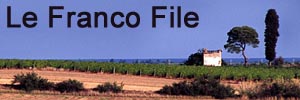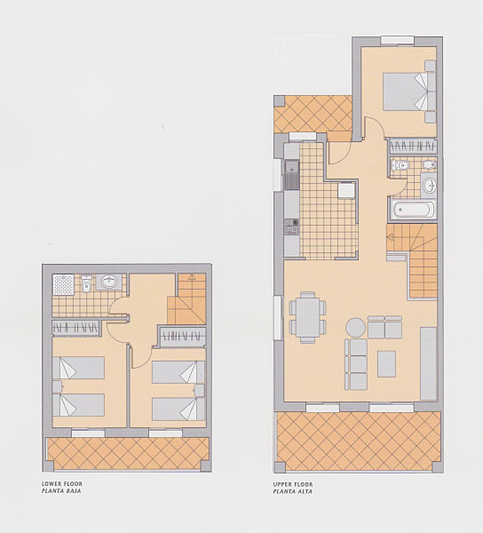Francine had a disturbing night; she was complaining of lights or streaks in the right periphery of her vision, most noticeable in the dark. The effect was still there this morning.
We were supposed to be going for a walk with neighbours but, with an amazing attack of sense, decided to try to consult a local optician beforehand. After all, at home, we’d be straight onto our friendly optician. There’s a suitable establishment in the village/small town (whatever it is), so we drove down and sat outside in the car waiting for 10:00 AM, the appointed opening time. That, of course, was 10:00 AM Spanish time. At 10:10 AM there were still no signs of life. At 10:15 AM, we were about to give up when, almost magically, the electrically controlled shutters began to rise. A young lady approached and began unlocking. We gave her a couple more minutes to get organized and then went in.
Fortunately, she had a few words of English. Francine explained her symptoms and asked if anyone could check her out. “Yes, I can”, replied the young lady. She could’ve stared into my eyes anytime she wanted – maybe I could develop some flashing lights. She sat Francine down, looked into her right eye and said, “you must go to hospital”, muttering something about her retina, along with a word which sounded horribly like “down”. There’s a 24-hour medical centre in Benissa just a few miles away but, no, we needed to go to Dénia hospital a few stops up the autopista. She also muttered something about laser. Gulp! “Come back and tell me what they do”, she said.
Off we set. The hospital was easy to find, which is just as well since we had no idea where we were going. At first, it looked much like an English hospital in that there seemed to be completely inadequate parking; cars were littered all over the place on the approach roads, round bends, on grass verges, almost anywhere they could be. Wondering where I’d be able to abandon ship, I dropped Francine off outside the urgencias door and went looking. I found an underground car park and followed another car down. I took a ticket, the barrier raised and I soon found several available parking spots. Maybe the Spanish who’d abandoned their cars all around the roads simply didn’t want to pay the €1.10 hourly charge. I went in search of Francine.
Any similarity with an English hospital started and stopped with the vehicles abandoned everywhere. Here was a shiny, clean, well decorated modern building that looked appropriate to its tasks. It took me about 10 minutes for find urgencias again but, when I did, there sat Francine, in a small waiting room, complete with a somewhat familiar plastic hospital admission band on her wrist. This one bore a QR code, though, which I doubt that ours have. She’d flashed her EHIC card and had been welcomed. A TV played high up in the corner of the room. The seats were pretty hard, though. We were waiting for triage.
After 15 minutes or so, a lady popped in and called “Francine”. We were shepherded into a room where, after a brief discussion with a lady with a little English and quick “light flicked over the eyes” test, something about opthalmology was mentioned. Back to the waiting room.
After 5 or 10 more minutes, another young lady turned up and led us through more doors on a much longer journey through the maze of bright, well decorated corridors, to another waiting room. This journey was more interesting since we have no Spanish and our escort had no English. We picked up a few sounds like “SIP” (we’d seen signs mentioning SIP – seemed to be a Spanish patient id, or some such) and tarjeta [card]. Francine produced her EHIC card again which promptly went for a walk, the word “later” trailing in its wake. Someone knew what they were doing, just not us.
We were in the consultas externas area, which sounds awfully like outpatients. A longer wait this time. We amused ourselves watching the electronic video screen which appeared to be summoning waiting patients, signified by “AAnnnn” numbers – maybe these were the SIPs – into various consultation rooms numbered 33-42. 38-42 were beside a sign saying oftalmologia.
Eventually Francine was called again, this time to have some dilating eye drops administered. Magically, her EHIC card had reappeared in the pocket of the eye drop lady and it was now accompanied by a proper Spanish patient number scribbled on a piece of paper. Her note also said she would be heading for room 40.
 Room 40 was running late; we had watched as its occupant had been called in order to assist a more complex case elsewhere, or that’s what we thought. We waited about 45 minutes while room 40 stood empty with its door wide open. Finally, room 40 swung back into action as the electronic board began summoning AAnnnn patients into it. A backlog had naturally built up but each patient was taking only 5 minutes or so. Francine’s AAnnnn appeared on the electronic board. We went in whereupon the doctor, sharp as a scalpel, swiftly realized Spanish wasn’t going to cut it. He switched to English to give both Francine’s eyes a minute examination, after which we were relieved to hear that, “your retina is OK now”. Read into that phrase what you will; we had to. Francine was “prescribed” some “vitamins to strengthen her eye”. I say prescribed but the prescription consisted of a note scribbled on a piece of A4 paper with a hospital stamp to make it look official. Excellent! Who needs more? Any pharmacist, we were told, would supply the pills. Vitamins for two months – far preferable to any laser treatment that might have been necessary. We didn’t care how much the pills would cost given the alternatives we had been fearing.
Room 40 was running late; we had watched as its occupant had been called in order to assist a more complex case elsewhere, or that’s what we thought. We waited about 45 minutes while room 40 stood empty with its door wide open. Finally, room 40 swung back into action as the electronic board began summoning AAnnnn patients into it. A backlog had naturally built up but each patient was taking only 5 minutes or so. Francine’s AAnnnn appeared on the electronic board. We went in whereupon the doctor, sharp as a scalpel, swiftly realized Spanish wasn’t going to cut it. He switched to English to give both Francine’s eyes a minute examination, after which we were relieved to hear that, “your retina is OK now”. Read into that phrase what you will; we had to. Francine was “prescribed” some “vitamins to strengthen her eye”. I say prescribed but the prescription consisted of a note scribbled on a piece of A4 paper with a hospital stamp to make it look official. Excellent! Who needs more? Any pharmacist, we were told, would supply the pills. Vitamins for two months – far preferable to any laser treatment that might have been necessary. We didn’t care how much the pills would cost given the alternatives we had been fearing.
Other than to worry about Francine’s condition, three hours in a Spanish hospital had been a very favourable experience and, frankly, had put our hospital experiences at home to shame. Don’t get me wrong, the care at home is good, when you eventually get it, but the environment and establishments themselves suck, in general. Just try a trip to A&E and see how you get on , what it looks and feels like, and how long it takes.
I didn’t feel too bright myself in the late afternoon/evening. I think, with the distraction of being busy now removed, nerves had finally kicked in and were making themselves known. An early night was in order.
Oh, the pills were about €35.
















Recent Comments